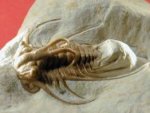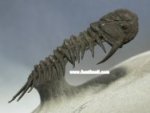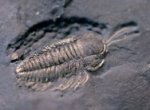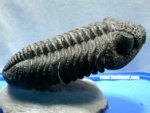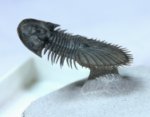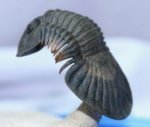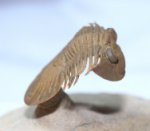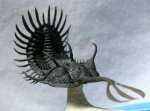Visit
these fossil dealer shops currently stocking trilobite fossils
for sale:
About
Trilobites
 The
Paleozoic is often called the age of the trilobite.Trilobites
particularly flourished in the oceans of the Cambrian and
Ordovician periods, beginning around 540 million years ago,
with a diminishing number of families persisting until the
Permian. The number of families actually peaked in the Late
Cambrian when an extinction event removed many. The morphological
diversity actually peaked in the Ordovician. Many more families
were removed at the end of
The
Paleozoic is often called the age of the trilobite.Trilobites
particularly flourished in the oceans of the Cambrian and
Ordovician periods, beginning around 540 million years ago,
with a diminishing number of families persisting until the
Permian. The number of families actually peaked in the Late
Cambrian when an extinction event removed many. The morphological
diversity actually peaked in the Ordovician. Many more families
were removed at the end of  the Ordovician 440 million years
ago during a great ice age where ice sheets advanced to the
equator. The diminished number of trilobite families that
survived to the Silurian radiated into new and exotic forms,
and still more exotic spiny and pustulose forms in the Devonian.
The Devonian was punctuated by periods of rising seas that
disrupted the reef systems where the trilobites flourished
forcing selective adaptation. The end of the Devonian saw
the Frasnian-Famennian event where only trilobite order Proteus
survived into the Carboniferous. Despite reduced ancestry,
with decent
with modification ruling, these trilobites filled the same
ecological niches such that adaptation led to a repeating
of many of the forms of their extinct cousins. While the
genetic path was assuredly different, the newly evolved forms
had recognizable morphological similitude with those long
extinct. Regrettably, trilobites never truly recovered in
the Carboniferous, with but a handful of genera extant by
the Permian. Failing to adapt to deep-water habitats, their
vulnerability to climatic change remained and led to their
disappearance prior to yet another great mass extinction
at the end of the Permian. The age of the trilobite yielded
to the age of the insect.
the Ordovician 440 million years
ago during a great ice age where ice sheets advanced to the
equator. The diminished number of trilobite families that
survived to the Silurian radiated into new and exotic forms,
and still more exotic spiny and pustulose forms in the Devonian.
The Devonian was punctuated by periods of rising seas that
disrupted the reef systems where the trilobites flourished
forcing selective adaptation. The end of the Devonian saw
the Frasnian-Famennian event where only trilobite order Proteus
survived into the Carboniferous. Despite reduced ancestry,
with decent
with modification ruling, these trilobites filled the same
ecological niches such that adaptation led to a repeating
of many of the forms of their extinct cousins. While the
genetic path was assuredly different, the newly evolved forms
had recognizable morphological similitude with those long
extinct. Regrettably, trilobites never truly recovered in
the Carboniferous, with but a handful of genera extant by
the Permian. Failing to adapt to deep-water habitats, their
vulnerability to climatic change remained and led to their
disappearance prior to yet another great mass extinction
at the end of the Permian. The age of the trilobite yielded
to the age of the insect.

 The
Paleozoic is often called the age of the trilobite.Trilobites
particularly flourished in the oceans of the Cambrian and
Ordovician periods, beginning around 540 million years ago,
with a diminishing number of families persisting until the
Permian. The number of families actually peaked in the Late
Cambrian when an extinction event removed many. The morphological
diversity actually peaked in the Ordovician. Many more families
were removed at the end of
The
Paleozoic is often called the age of the trilobite.Trilobites
particularly flourished in the oceans of the Cambrian and
Ordovician periods, beginning around 540 million years ago,
with a diminishing number of families persisting until the
Permian. The number of families actually peaked in the Late
Cambrian when an extinction event removed many. The morphological
diversity actually peaked in the Ordovician. Many more families
were removed at the end of  the Ordovician 440 million years
ago during a great ice age where ice sheets advanced to the
equator. The diminished number of trilobite families that
survived to the Silurian radiated into new and exotic forms,
and still more exotic spiny and pustulose forms in the Devonian.
The Devonian was punctuated by periods of rising seas that
disrupted the reef systems where the trilobites flourished
forcing selective adaptation. The end of the Devonian saw
the Frasnian-Famennian event where only trilobite order Proteus
survived into the Carboniferous. Despite reduced ancestry,
with decent
with modification ruling, these trilobites filled the same
ecological niches such that adaptation led to a repeating
of many of the forms of their extinct cousins. While the
genetic path was assuredly different, the newly evolved forms
had recognizable morphological similitude with those long
extinct. Regrettably, trilobites never truly recovered in
the Carboniferous, with but a handful of genera extant by
the Permian. Failing to adapt to deep-water habitats, their
vulnerability to climatic change remained and led to their
disappearance prior to yet another great mass extinction
at the end of the Permian. The age of the trilobite yielded
to the age of the insect.
the Ordovician 440 million years
ago during a great ice age where ice sheets advanced to the
equator. The diminished number of trilobite families that
survived to the Silurian radiated into new and exotic forms,
and still more exotic spiny and pustulose forms in the Devonian.
The Devonian was punctuated by periods of rising seas that
disrupted the reef systems where the trilobites flourished
forcing selective adaptation. The end of the Devonian saw
the Frasnian-Famennian event where only trilobite order Proteus
survived into the Carboniferous. Despite reduced ancestry,
with decent
with modification ruling, these trilobites filled the same
ecological niches such that adaptation led to a repeating
of many of the forms of their extinct cousins. While the
genetic path was assuredly different, the newly evolved forms
had recognizable morphological similitude with those long
extinct. Regrettably, trilobites never truly recovered in
the Carboniferous, with but a handful of genera extant by
the Permian. Failing to adapt to deep-water habitats, their
vulnerability to climatic change remained and led to their
disappearance prior to yet another great mass extinction
at the end of the Permian. The age of the trilobite yielded
to the age of the insect.
